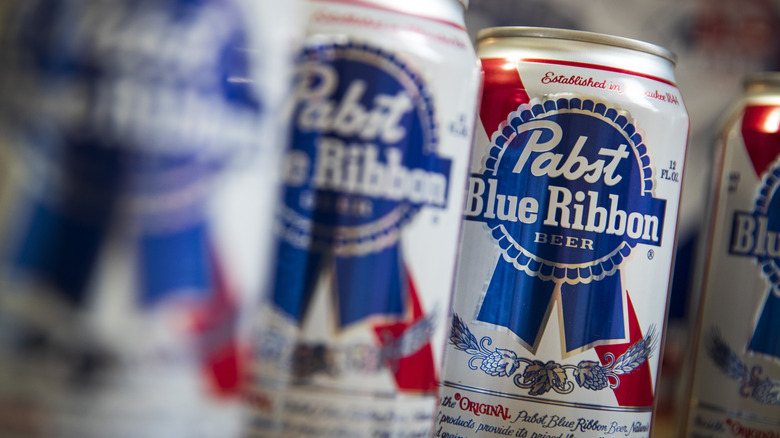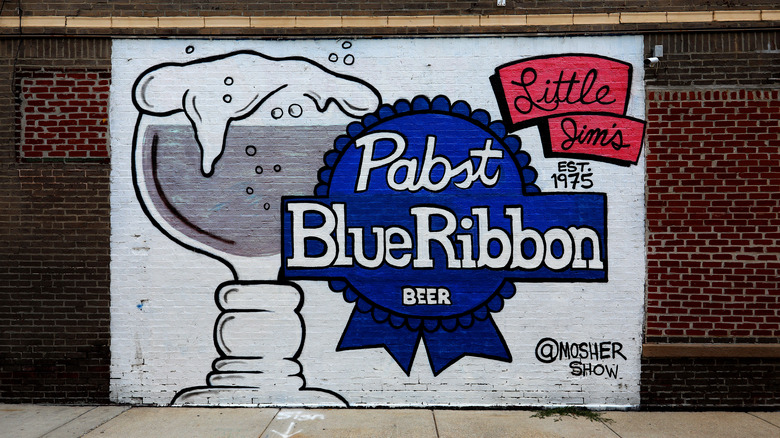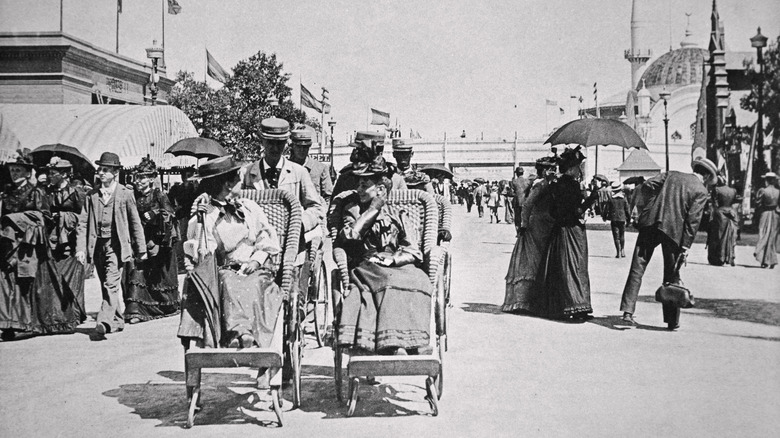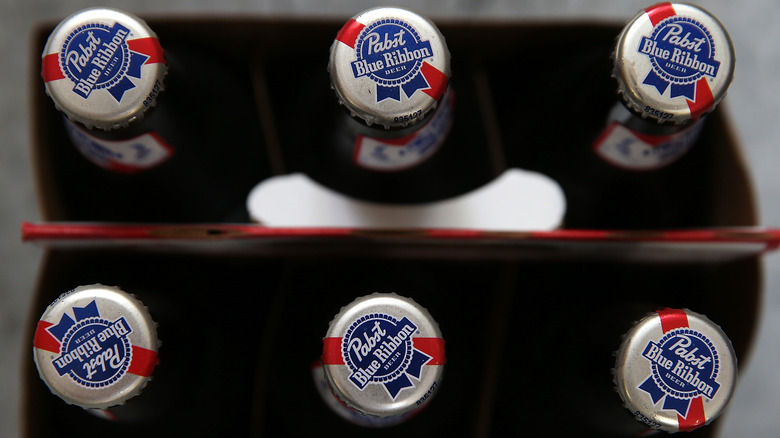Here's How Pabst Blue Ribbon Got Its Name
As a drink of choice for college students and underground scenesters, Pabst Blue Ribbon is well-loved by its fans. The New York Daily News reported in 2013 that PBR significantly contributed to that year's rising beer prices. The beer company was named the fifth-largest brewing company in the U.S. in 2021, according to an annual report released by the Brewer's Association. Considering that Pabst Brewing was founded back in the 1840s, per the company's official website, the brand has retained popularity for quite some time. Even so, the brewing company is no stranger to bumps in the road — like the drawn-out legal entanglements with fellow beer company MillerCoors over a 20-year contract, and which NPR noted was settled in 2018.
The adoration for PBR makes sense: It's an affordable, easy-to-drink lager. Although PRB has in many ways attained something like celebrity status by now, there's a chance there may be a lot you don't know about Pabst Blue Ribbon or its origins. Throughout its long history of bringing a buzz to the masses, Pabst Blue Ribbon has also been through quite a few name changes — and the one we call it now was a long time in the making.
Is Pabst Brewing Company not really a brewer?
There's a fire that keeps Pabst Blue Ribbon's engine going, but it has almost nothing to do with beer. Technically, the Pabst Brewing Company is not even a brewery but instead outsources from MillerCoors and slaps its own iconic logo onto the cans. In their write-up of the company, NPR quoted an economics professor who told Marketplace that PBC could be considered a "beer marketing company" rather than a brewer. So if it's not about the hops or the satisfying pop of opening a fresh can, then what is it that people like about PBR?
For most, it's name recognition. Pabst Blue Ribbon is as much a pop culture symbol as it is a drink. Its logo is so renowned that it has reached icon status. Some Pabst marketing campaigns are unconventional. Its latest endeavors include the construction of a nostalgic PBR-themed motel, according to American Craft Beer; in a similar stunt, Vinepair reported the brand is now even selling a huge 1,844-pack of its beer.
PBR aims to "show up authentically in the places and spaces" frequented by its fan base, the brand's VP of marketing told The Takeout in June 2022. At one point, enthusiasts could even stock up on household items and turn their homes into advertising space for the company, according to the PBR website. The brand awareness strategy isn't new but goes back to 1860, beginning with Frederick Pabst. (A man who wasn't the company's founder, no less.)
Captain Frederick Pabst's vision for PBR
Captain Frederick Pabst became vice president of the Pabst Brewing Company in 1864, and in doing so brought a vital change in perspective to the company. According to the Pabst Mansion museum website, Frederick Pabst was an expert advertiser and brand builder, both qualities that have since solidified PBR's reputation and success. Pabst liked putting on big spectacles in order to build up a positive image for the company. In 1893, he even went so far as to shell out for a display at the infamous Chicago World's Fair. The elaborate booth was made of terra cotta, speckled in gold leaf, and featured statues and models to display Pabst products.
The marketing scheme ultimately worked, and attendees were beyond impressed. It became a tradition, of sorts: The current Pabst company brand continues to use this strategy to build its brand, aligning itself with brands like Vans and even celebrity spokespeople like Will Ferrell to appeal to new generations. These stunts make PBR impossible not to notice, and everyone starts to want a taste. Think about it — when you buy a PBR t-shirt, is it because you love the taste of the beer? Or is it for the blue ribbon and the iconic name?
The origins of the iconic PBR name
So what does all of this have to do with PBR's name? A lot, actually: It comes with a long history and the title flip-flopped a few times. Pabst Brewing Company was initially founded in 1842, when Jacob Best, Jr. along with his brother Charles, came from Germany to America, according to the Pabst Mansion's official website. Setting down roots in Milwaukee, Jacob opened the brewery Best and Company in 1844 with the help of his four sons. Years passed, and three of the brothers had left to start their own brewing company — which would later become known as Miller Brewing Company — leaving Jacob and his son Phillip to their own. Jacob retired in 1853, and in 1859, Phillip became the owner of the brewery, which he promptly renamed the Phillip Best Brewing Company.
It wasn't until Philip's daughter married Frederick Pabst that the name we all know came about, as the Pabst Mansion website notes. In 1864, Pabst became the vice president of the company by purchasing half of it for roughly $21,057.05. Phillip Best died in 1869, but the name remained the same until March 12, 1889, when the title was officially changed to the Pabst Brewing Company.
The blue ribbon came in around 1882 when Pabst started receiving awards all over the U.S. for its brews.The company later decoratively added blue ribbons to its "best select" beer bottles, per Pabst. In 1899, the name finally changed one last time to Pabst Blue Ribbon. Now, over 100 years later, it's become something of a legend.



